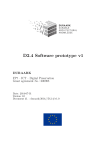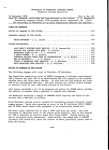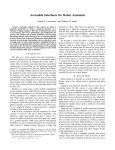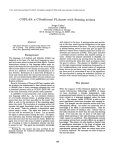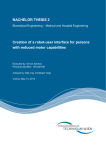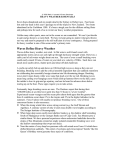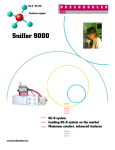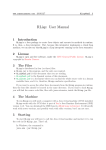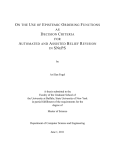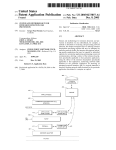Download bachelor thesis - Common
Transcript
Cram Design & Implementation of a Reactive Plan Language Tobias Christian Rittweiler May 5, 2010 Abstract CRAM, the Cognitive Robotic Abstract Machine, is a toolbox aimed at the design, implementation, and deployment of cognition-enabled mobile robots. Its core consists of the CRAM Plan Language (CPL) which is a new incarnation of the Reactive Plan Language (RPL) by McDermott et al. CPL is a modernized, truly Common Lisp based, compiled domain specic language to express robots' execution plans as concurrent reactive control programs with rich control structures for perception-guided control and failure detection, classication and handling. In particular, it features a multithreaded architecture to benet from the concurrency available in today's multiprocessor systems. This bachelor thesis will cover the rationale, details of implementation, and outlook after a major revision of the underlying multithreaded architecture. Furthermore, it will contain an attempt at a coherent description of the language, including usage examples and additional tools that may be useful to its user. 1 Introduction Cram set (Cognitive of are distinct, specially Robot yet Abstract highly designed Machine) interconnected to enable is tools robots to a that per- form mobile manipulation and cognition-enabled control, for example to empower mobile agents to per- form everyday manipulation tasks in human environments like current the a kitchen. research laboratories tems Group at See objects of the the g.1 making Intelligent Technical for use one of of Autonomous University the Cram of in SysMu- nich. Cram sits on top of the Ros middle-ware which provides a distributed framework of nodes that are interconnected Figure 1: Rosie to share services with each other. Fig.2 depicts the architecture employed in Cram. All its building blocks are implemented inside 1 Ros CPL Extension Modules computable predicates CRAM-kernel KnowRob Reasoner SWI Prolog Program code query ROS interface KnowRob Extension Modules Program code OWL computable predicates ROS interface Program code Program code ROS interface OWL computable predicates ROS interface Program code population of the belief state ROS interface CPL - CRAM Plans Program code ROS interface Program code Belief State - Object designators - Entity designators - KnowRob knowledge base assert retract query ROS interface LISP Program code Program code OWL computable predicates ROS interface Program code OWL computable predicates ROS interface Program code OWL computable predicates ROS interface ROS interface activation/deactivation/parametrization using ActionLib abstraction Program code Navigation Perception Manipulation OWL computable predicates ROS interface Figure 2: Architecture of Cram nodes, and it hence benets from the modular and extensible architecture of Ros. As can be seen in g.2, the core of of the Cram Cram is very lightweight; it consists Plan Language and interfaces to provide plans access to the belief state, to perception, to navigation, and to manipulation facilities like the arms of Rosie (g.1). In detail: Cram Plan Language (Cpl) Cpl is very expressive behaviour specication language that unies con- trol programs to be executed and plans to be reasoned about into the same language essentially by allowing the programmer to annotate his programs with reasoning information. This unication allows to infer semantics of the code being executed and to use this information, coupled with other resources, to verify that a robot achieved all its goals, to detect potential aws in the execution plan by means of projection, and possibly to repair it based on the projected outcome. The Cram Plan language can be seen as a successor, or a modern reimplementation, of the Reactive Plan Language (Rpl).[2] Like Rpl, it is based on the idea of semantically-annotated plans to support high-level reasoning and plan transformation. Furthermore, its implementation is based on Rpl concepts like tasks, and uents. However, Rpl was implemented as an interpreted, multitasking-emulating language on top of McDermott's dialect Nisp.[3] Contrarily, Cpl is implemented as a compiled, natively- multithreaded language on top of Common Lisp. 2 Cpl itself consists of three parts: 1. Tasks, which represent threads of execution in a plan to, ultimatively, achieve goals like navigate to position (x, y); tasks are organized in trees as it's common that a task requires additional sub tasks for its accomplishment. 2. Fluents (and uent-nets), which act as a synchronization abstraction for convenient inter-task notication on value changes an essential ingredient of autonomous agents, considering their need to react on exogenous events. 3. Control structures of the language, which are implemented on top of tasks and uents. Cram Designators Designators are symbolic descriptions of entities such as objects (mugs, plates, ...), locations or parameterizations of actions. Designators unify symbolic and grounded concepts in a plan with the parameterization of the lower level components, which is necessary to eciently reason about the execution of plans.[4] Cram Process Modules Process Modules provide interfaces to lower-level control processes that can be activated, deactivated and parameterized by the high-level control program. They resolve symbolic properties of designators and generate the parameterization of the low-level control routines, by taking the current belief state into account.[4] Cram Execution Trace The execution trace records internal state of the control program and the belief state at any point in time. The information is useful not only for debuggability but also provides the mechanisms for complex monitoring and failure handling that is not based on local failures and exception handling but on the expressive formulation of error patterns in rst order logics.[4] Cram Reasoning The reasoning component includes a bridge between Cpl and KnowRob[10], an extended knowledge base, by incorporating the foreign language interface of Swi-Prolog into Common Lisp. component based on the Rete It further includes a reasoning algorithm and a library of predicates that allow for reasoning about plan execution, based on the execution trace.[4] 3 This bachelor thesis will discuss implementation issues, and document design decisions of the Cram Plan Language. It purports to serve the following two purposes: a) it shall assist the author's superviser in wrapping his head around the new implementation, and, more importantly, it shall act as guide for further development; b) it shall be passed on to fellow students and collegues to help them get started on 2 Cram. Cpl The Implementation As mentioned in the introduction, the Cram Plan Language is implemented on top of two concepts called tasks and uents. In the next section we will rst provide an overview of these two concepts, and how their combination leads to a domain specic language that expresses execution as concurrent reactive plans. In the sections following, we will then discuss a major revision of the multithreaded architecture underlying tasks. In particular, we will argue why a revision was needed and we will illustrate problems and pitfalls encountered during the reimplementation. Finally, we will provide insights on the remaining work to be done. 2.1 Concepts We will start with a brief description of what uents are. Although they play only a marginal role with respect to this thesis, they still represent an essential part of the system. A uent contains a value. 1 Tasks can wait on a uent, and are notied in case the value changes (see g.3). More interestingly, multiple uents can be combined in what we call a uent network: essentially, a uent bases its value on the value of another uent and subscribes to that other uent. If the other uent changes its value, this change will propagate to the subscribed uent whose value will then be recalculated (again, see g.3). As robots have to react on exogenous events (ideally in an intelligent way), an important use of uents is to map such events into the system. However, uents are actually used throughout the system everywhere where values change over time and where a change of value may lead to change in behaviour. Plans are control programs that are annotated with enough semantic information that they can be reasoned about. high-level and reasoning aspects of Cram, As this thesis does not discuss the we can regard plans simply as de- scriptions of behaviour. Internally, they try to achieve some goal by splitting the achievement into tasks. Conversely, a task represents a thread of execution in a plan. In fact, tasks are precisely that: threads plus appropriate metadata. As tasks are often partitioned again into subordinated tasks, tasks are naturally 1 Both edge-triggered and level-triggered notications are supported. 4 Figure 3: Fluents, schema. 2 organized in trees, or rather hierarchies : a task is in control of its sub tasks; it determines which of its sub tasks are crucial (and must be accomplished for the accomplishment of the task at a whole), it determines how to react on failures of sub tasks, or what to do with sub tasks which became superuous. For purpose of this thesis (again we're neglecting semantic annotation), the Cram Plan Language can now be seen as a language which allows to specify task hierarchies conveniently and concisely. In particular, it species the relations between a task, its sub tasks, and among the sub tasks. Each Cpl control structure (which will be described in detail in section 3.1.3) represents a particular variant of such a relation. And by combining the control structures, a user can thus achieve complex task hierarchies with complex inter-dependent behaviour. Cpl includes variants such as: • All sub tasks should be accomplished. • It's enough if one of the sub tasks is accomplished. • Sub tasks must be accomplished according to a particular partial order. • Suspend some of the sub tasks, do something else, resume tasks. And many more. To enforce such a relation, a task subscribes to its sub tasks' status uent which contains the state a task is in. Thus if one of the sub tasks changes its status (e.g. to indicate it's accomplished), the subscribed parent will be notied and can proceed as desired for instance, to wait again on the uent until all other sub tasks are accomplished, too, or to shut down remaining sub tasks and change its own status to accomplished. 2 To describe the relation between a task and its subordinated task we sometimes use the terms task and sub task, and other times parent task and child task. The former expresses their hierarchical role, and the latter expresses their organization as data structure. 5 Figure 4: A task's state diagram As can be seen, getting tasks right is all about getting inter-task communication right. And since tasks are executed in threads, it's actually about getting interthread communication right with the caveat that this communication should mostly be performed implicitly without user's direct notice. Inter-task communication is tied to state transitions in tasks. This makes sense as we said that a task is supposed to control its sub tasks, and inter-task communication is the means for a task to induce state transitions in its sub tasks. Fig.4 illustrates the interplay of states in a task. exit states: :succeeded Notice that there are three means the task was accomplished, task could not be accomplished, and :evaporated :failed means the means the task became su- peruous and was killed by its parent. 2.2 Old Task Implementation As described previously, the key part in implementing the Cram Plan Language is the intercommunication between tasks belonging to the same hierarchy. The old implementation used the function interrupt-thread for that purpose, a common extension provided by multithreaded Common Lisp implementations. For example, a parent task would have executed the following to evaporate its children: (dolist (child (child-tasks *current-task*)) (interrupt-thread child #'(lambda () (signal 'termination)))) interrupt-thread interrupts the passed thread and makes it execute the passed function instead of what it was executing before in this case, to signal a condition which indicates that the child is supposed to be torn down due to evap- 6 oration. A suspension was requested analogously but by a condition named suspension. Each task was executed in a context where appropriate handlers for termination and suspension were active. This implementation technique is neat in so far as it only involves minimal code, and reuses the ingredients of the Common Lisp maximally. Albeit neat, this implementation technique is seriously awed. The problem is that interrupt-thread works by interrupting the passed thread totally asynchronously, at whatever point it is currently executing. Conse- quently, a task could have been evaporated, or suspended, at any time. And evaporation leads to unwinding, suspension leads to waiting at any time. There are times, however, where an unexpected unwinding, or waiting, would result in rather dire consequences: 1. What if a a task is forced to unwind from amid a critical section? Likely, it will leave inconsistent state behind, for instance, in the object being modied in the critical section. 2. What if a task is forced to unwind while executing a cleanup clause of unwind-protect? At best, we'll leak some ressource. Or, again, inconsistent state. 3. What if a task is suspended within a critical section? The suspended task will continue to hold some lock. If another task wants to acclaim that lock, it won't be able to do so until the suspended task is resumed. But if the other task is the one responsible for waking up the suspended task, a dealock will occur. As implementations usually provide some means to disable the receiving of interrupts for the duration of some forms, all of these issues can in principle be catered for. And there may even be ways to proactively help the user address these issues: For example, software transactional memory may be used to solve the rst issue and prevent inconsistent state by rolling back state changes before unwind; unwind-protect could be implemented to disable interrupts while ex- 3 ecuting the cleanup forms to obliterate the second issue ; and for addressing the third issue, an abstraction could be provided that a) allows the user to specify safe places to unwind to on suspension, and b) how to rewind again on wake up akin to Scheme's dynamic-wind. However, all these mechanisms do not really change the crucial properties that seem to be inherent in asynchronous interrupts: 3 There may be situations where a cleanup form is so complex and may involve so much time that it should in fact be interruptible. For that purpose, implementations should provide a means to locally reenable interrupts in an unwind-protect cleanup form. We argue, however, that it strikes us as the better policy to disable interrupts by default, and have the user enable them explicitly, rather than the other way around if only to cope with users' mental model of unwind-protect. 7 • To reiterate as it's so important: asynchronous interrupts can happen time, between and in-between • any any line of code. Interrupt-safe code does not compose. Even if a piece of code considered on its own deals with interrupts sensibly, does not necessarily mean that sensible transfers to all usages.[9] Consequently, interrupt-safety cannot be localized into a small, heavily audited code area, but would have to be catered for across the whole source base; not only in user code, but also in the sources of the implementation, in third-party code, literally everywhere. Programming would require whole-world knowledge those who have not ascended yet would have to program in angst and sorrow or, alternatively, in ignorance. 4 Angst and sorrow is not mere rhetorics. As a case in point, we want to de- scribe a puzzling phenomenon of the old implementation: when running the test suite, every now and then a frightning compilation aborted message was printed to the screen without any further information. It turned out that timing issues in one of the test cases spured an evaporation right during the computation of the discriminating function which typically involves compilation in a Clos implementation. The evaporation caused unwinding out of the compila- tion which thus caused the message to be printed. Another case in point. Let's revisit our previous code snippet: (interrupt-thread thread #'(lambda () (signal 'termination))) 5 to the following Java code Notice that the above is tantamount thread.stop(new Termination()); Thread.stop (and Thread.suspend for that matter) were deprecated 10 years ago. In [1], the rationale behind that decision is explained; it can be summarized with one quote: In sum, it just isn't practical. 2.3 New Task Implementation interupt-thread Thread.interrupt, it begets diers from interrupt-thread that it's In Java, an InterruptException is not thrown We concluded the last section by comparing Common Lisp's Thread.stop. As Java also question how Thread.interrupt to Java's the not plagued by the same issues. provides a at arbitrary times, but only in predened places. The user is supposed to extend 4 The only real way out, it seems, would be to disable interrupts globally, or for vast areas of code. Of course, that would render the implementation technique being discussed pretty useless. 5 We're neglecting the fundamental dierence that signaling a condition in Common Lisp does not necessarily lead to stack unwinding. 8 this set of places appropriately. Thus interrupts in Java are not asynchronous. In general, programmatic use of interrupts should be dealt with by whitelisting rather than blacklisting: dene a set of places where interrupts are supposed to be triggered enough to be adaquately responsive, not too many not to incur too much overhead. The obvious advantage is that the problem of having to deal with interrupts all over the place will be gone immediately. Interrupts will now be localized. Sbcl includes a feature called deadlines 6 which could be summarized as global (or thread-local) timeouts based on the aforementioned whitelisting approach. A deadline is an absolute time pointing into the future, and a couple of internal functions check whether current time exceeds the current deadline. If that's the deadline-timeout. These functions get-mutex, condition-wait, wait-on-semaphore, and serve-event case, they will signal a condition of type include (the recursive event loop used for I/O). An restart is associated with the condition deadline-timeout to defer the just expired deadline again into the future. On behalf of that restart, one can use deadlines to periodically execute a function and continue the original computation after that function has run. This is what the new task implementation is based on. Indeed the new implementation works as follows: 1. Each task is executed with the deadline mechanism being activated. 2. Each task establishes a handler for deadline-timeout that invokes the task's event loop. 3. The event loop looks for new messages in a mailbox: 6 Caveat: deadlines aren't actually exported from a public package, and are not available on all platforms (as of Sbcl 1.0.38.) 9 • If no new message has arrived, the restart is invoked to continue the computation where the deadline was triggered. The restart also reinstalls the deadline so that we will enter the event loop again after a while. • If a new message has arrived, it's processed. The message encodes another task's request for evaporation, suspension, or wakeup. An evaporation request leads to tear down which includes: a) sending evaporation requests to the current task's children, b) changing status to :evaporated, and c) exiting. A suspension request is rst propagated to the current task's children, then the task simply stays in the event loop and waits on the mailbox for new messages. Notice how the current continuation resides on the stack and is invokable through the restart during the time a task is suspended. Hence a wake up means nothing more than invoking said restart (after the wake up was propagated to the current task's children, of course.) 7 The implementation can easily be illustrated with the following 60 lines of code: ( defstruct ( task (: constructor make− t a s k (& k e y name function name function children ( status : created ) ( mailbox ( defvar ( sb − c o n c u r r e n c y : make−m a i l b o x ) ) ) ∗ c u r r e n t −t a s k ∗ nil ) ( d e f c o n s t a n t +p e r i o d+ 0 . 0 1 ) ( defun ( setf ( defun c h a n g e−s t a t u s ( task new− s t a t u s ) ( t a s k −s t a t u s task ) new− s t a t u s ) ) execute ( task ) ( sb − t h r e a d : make− t h r e a d # '( lambda ( let () ( ( ∗ c u r r e n t −t a s k ∗ ( c h a n g e−s t a t u s ( call ( defun call task task )) : running ) −w i t h −e v e n t −l o o p task ( t a s k −f u n c t i o n −w i t h −e v e n t −l o o p ( t a s k t h u n k ) ( ( sb − s y s : d e a d l i n e −t i m e o u t ( h a n d l e r −b i n d # '( lambda 7 The code requires an Sbcl (c) version of 1.0.38 or higher. 10 task ) ) ) ) ) ) children ))) ( e v e n t −l o o p task # '( lambda () ( sb − s y s : d e f e r − d e a d l i n e +p e r i o d+ c ) ) # '( lambda () ( r e t u r n −f r o m ( sb − s y s : w i t h − d e a d l i n e ( unwind− p r o t e c t ( funcall ( p r o p a g a t e −m e s s a g e ( defun ( let e v e n t −l o o p ( ( mailbox ( waitp ( task call −w i t h −e v e n t −l o o p ) ) ) ) ) ) ( : s e c o n d s +p e r i o d +) thunk ) task : evaporate ) ) ) ) ) continue ( t a s k −m a i l b o x finish ) task )) nil )) ( loop ( m u l t i p l e − v a l u e −b i n d ( if ( message received ?) waitp ( sb − c o n c u r r e n c y : r e c e i v e −m e s s a g e ( values ( sb − c o n c u r r e n c y : r e c e i v e −m e s s a g e −no−hang ( when ( ecase task ( t a s k −s t a t u s ( funcall ( : suspended ( setq ( : evaporated ( funcall p r o c e s s −m e s s a g e ( task task message ) ) task ) ( : running ( p r o p a g a t e −m e s s a g e ( ecase continue )) waitp t )) finish ))))))) message ) message ) message ( : suspend ( c h a n g e−s t a t u s task : suspended ) ) ( : wakeup ( c h a n g e−s t a t u s task : running ) ) ( : evaporate ( c h a n g e−s t a t u s task : evaporated ) ) ) ) ( defun p r o p a g a t e −m e s s a g e ( dolist t) mailbox ) ) received ? ( p r o c e s s −m e s s a g e ( defun mailbox ) ( child ( task message ) ( t a s k −c h i l d r e n ( sb − c o n c u r r e n c y : s e n d −m e s s a g e task )) ( t a s k −m a i l b o x child ) message ) ) ) Notice that we haven't addressed failure handling neither in the description nor in the exemplary implementation. The reason is that failures aren't actually implemented by messages, but implicitly through join-task (see section 3.1.1). Further notice that the exemplary implementation does not address the problem of suspending in mid of a critical section. For example, a deadline signaled in condition-wait may invoke a task's event loop while holding the lock associ- ated with the relevant condition variable. And, as uents are implemented on top of condition variables, getting this issue right was a requirement right from the beginning. It was one of the aspects in the real implementation which was 11 a tad bit tricky to implement correctly. Let's sketch how we did it: 1. We provide a macro retry-after-suspension which is supposed to un- wind out of a critical section right before suspending and to re-execute the critical section on wake up. Essentially it's an adaption of the dynamic-wind idea from page 7. 2. retry-after-suspension registers a callback which is invoked when the event loop processes a suspension request. 3. This callback performs three things in the following order: (a) It unwinds out of the body of retry-after-suspension. (b) It reestablishes necessary context which was lost due to the unwind; e.g. it reestablishes the deadline and makes up the deadline's associated restart. (c) It continues the suspension process so we will eventually end up back in the event loop waiting on the mailbox. Excursion While trying to implement retry-after-suspension for the rst time, we were majorly screwed by an ideosyncracy of Common Lisp's condition system. Kent Pitman, author of the chapter about the condition system in the Common Lisp Ansi standard, writes in [6]: Probably the most controversial semantic component of the Common Lisp condition system is what has come to be called the "condition rewall". The idea behind the condition rewall is that a given handler should be executed in an environment that does not "see" intervening handlers that might have been established since its establishment. And, indeed, the Ansi standard is very explicit on the issue:[7] Handlers are invoked in a dynamic environment equivalent to that of the signaler, except that the set of active handlers is bound in such a way as to include only those that were active at the time the handler being invoked was established. Let's try to illustrate the exact meaning and its consequences on behalf of an example: 12 1. 2. (handler-case (handler-bind ((warning #'(lambda (c) (declare (ignore c)) (error "Got a warning! Turned it into an error.")))) (warn "A warning:")) (error (e) (declare (ignore e)) (format t "Caught an error.~%"))) (handler-bind ((warning #'(lambda (c) (declare (ignore c)) (error "Got a warning! Turned it into an error.")))) (handler-case (warn "A warning.") (error (e) (declare (ignore e)) (format t "Caught an error.~%" c c)))) In the rst form, the warning is rst turned into an error, the error is caught by the handler-case and thus only a message is printed. In the second form, however, the handler established by handler-case is actuhandler-bind so ally out of scope when executing the handler established by the error will propagate through and cause an invocation of the debugger. The specied behaviour makes sense as it ensures that the scope of handlers with respect to each other is lexical: a handler X that is established textually before Y, will will only see those handlers that appeared textually before X. This is an important property as the handler X may in fact not know about the exact state of aairs down its line. (As a special case, consider how easily one could be tricked into endless recursion between a handler-case handler-bind and a nested if the condition rewall were not in place.) So what's the matter? Let's recall that we enter the event loop through a deadline handler. And this deadline handler is the outermost handler within a task's execution as can be witnessed from the exemplary implementation above. So a consequence of the condition rewall is that we cannot reuse Common Lisp's condition system to communicate between the event loop and implementation details (e.g. up by macros like retry-after-suspension) down the stack. set Any handler established down the stack will be out of scope in the event loop. This property of Common Lisp's condition system puts a pretty harsh restriction on using deadlines as a way to invoke an event loop periodically. Although we see the new task implementation as described in this section as a major 13 improvement over the previous implementation, we will propose a slightly different implementation strategy in the next section which will also overcome the condition rewall. 2.4 Future Work To recapitulate: In section 2.2, we argued how problematic the previous implementation was due to its use of asynchronous interrupts. We argued that trying to tame asynchronous interrupts resembles the duty of Sysiphus because to reason about them would require knowledge about the whole software stack. We compared the old implementation technique to Java's Thread.stop which has long been deprecated for these reasons. In section 2.3, we argued that programmatic use of interrupts (like we intend to do) should be based on whitelisting rather than blacklisting. We provided Java's interrupt mechanism as an example for how it's supposed to be done. Further, we proposed Sbcl's deadline mechanism to be such a mechanism. This begets the question now in how far exactly deadlines compare to Java interruptions. Both, deadline and Java interrupts, are raised in a handful of predened places in fact, almost the same places. However, Java's InterruptException is a checked exception, so it's an explicit and permanent part of the places' API (even enforced by the compiler). The crux is that handling InterruptException not only enforced for direct callers but for all callers. programmer knows precisely where in a system interrupts can occur. same cannot be said on the Lisp side: is It follows that a Java The a deadline can, for example, expire get-mutex no matter what mutex was passed to it. Consequently, deadline-timeout can actually be signaled from within any function that within a makes use of synchronization internally (or uses one which does). And these internal details really do leak. Case in point: a semaphore is implemented 8 on top of mutexes and condition variables. So a may be signaled within wait-on-semaphore deadline-timeout while holding the mutex that ac- tually is completely internal to the semaphore. If we enter the event loop under such circumstances, and process a suspension request, we just rendered the semaphore unusable and danger awaits. Notice that our hands as user are tied on the issue; we cannot just modify the implementation of semaphores to use our retry-after-suspension. It follows that any direct, or indirect use of semaphores is liable to lead to problems. 9 Any dream of reasonability is gone. Notice that in the old task implementation, the processing of requests could 8 As of Sbcl 1.0.38. 9 We were bitten by it: spawning a thread, thus executing a task, uses a semaphore inter- nally. As the semaphore is purely internal, no deadlock was warranted. However, problems arose nontheless because a parent task could enter its event loop before its child was properly set up. We solved this issue by locally disabling deadlines using section 3.1.1 for a description.) 14 without-scheduling (see happen anywhere. In the new task implementation, it can only happen where synchronization or I/O is directly or indirectly used. So it's denitively a step forward. However, for the reasons of unpredictability (and for the problems due to the condition rewall discussed in the previous section), we actually dimiss 10 deadlines as a viable implementation strategy for our purpose. We will now conclude our discussion of the implementation with outlining an approach which diers only slightly but to great eect: • We still want to periodically enter a task's event loop where requests are received and acted upon. • However, instead of using deadlines provided by Sbcl for that purpose, we propose to essentially implement our own deadline mechanism (which will then be used in our code only): We subclass, or write wrappers as appropriately, for locks, condition variables, semaphores. These wrappers check whether our deadline expired. We check for expiration in appropriate places like waiting on a uent. If necessary, we add loop abstractions for the user which internally check the deadline. (So the user does not have to be bothered with checking for expiration himself.) As plans usually involve uents en masse, we suppose it's a rather rare circumstance. If our deadline expires, we won't signal a condition, but either directly invoke the event loop, or go over the indirection of a special variable. • As we implement deadlines ourselves, the now current architecture can mostly be kept just as is. The advantages of the outlined approach include: 1. We can make use of retry-after-suspension in the wrappers appropri- ately. 2. Since it's all wrapped up and the deadline mechanism is provided by ourselves, our code can become portable across implementations again. 3. The event loop will only be triggered by our own code, so reasoning won't require whole-world knowledge. 4. We circumvent the problems induced by the condition rewall. 10 To be precise: We dismiss the implementation of deadlines as of Sbcl 1.0.38. 15 Cpl - A User's Guide 3 The following section is probably the section most interesting to future users of Cram and Cpl. A note of caveat to these users: the following descriptions should provide a good head start, but Cram was still in quite an early stage of existence as of the writing of this thesis. We're pretty certain, though, that the essential bulk of behaviour will stay as described here, details may dier slightly, however. 3.1 The Language 11 3.1.1 Tasks [Variable] *current-task* Inside a task, contains the task object being executed. Otherwise, [Classes] A nil. abstract-task, toplevel-task, task toplevel-task represents the root of a hierarchy of make-task &key name function Create an object of class task named name. tasks. [Function] If executed, it'll execute function, a thunk. [Function] execute task Spawn a thread, and have it execute the function associated with induces a status transition from :created to :running. task. This child-tasks task Return all the children of task. [Accessor] [Accessor] status task Returns a uent whose value is the current status of Example task. Being a uent, one can easily wait for status transitions of a task. The following will wait until a task, which was just created, will actually excute, or until a task, which was suspended, will execute again: (wait-for (fl-eq (status task) :running)) 11 This section is mostly a reference. For a description on the concepts involved, please refer to section 2.1. 16 [Type] status-indicator One of • :created, • :running, • :suspended, • :succeeded, • :evaporated, or • :failed. [Constants] +dead+, +done+, +alive+ A task is... dead if it either succeeded, failed, or was evaporated. done if it either succeeded, or was evaporated. alive if it either has not run yet, is currently running, or is suspended. [Accessor] result task Return the result of the task. For multiple values, this function also returns multiple values. Setfable. join-task task Wait until task has nished. When task fails, this function resignals the failure condition. When task succeeds, this function returns its result values as multiple values. [Function] 17 suspend task &key reason sync suspension request to task. This request [Function] Sends a will be propagated to all its children (and then to their children, and so on.) For debugging purposes, reason is a string which will displayed as part of the logging output described in section 3.2.2. By default, the current task (that is the caller of really becomes suspended. If sync suspend) won't wait until task is true, the current task will wait until task and all its children are suspended. Notice the dierence between Example (progn (suspend task) (wait-for (fl-eq (status task) :suspended))) and (suspend task :sync t) is that the former will only wait until will wait until task task becomes suspended, while the latter and all its children become suspended. wake-up task &key reason sync request to task to wake up from an [Function] Sends a request will be propagated appropriately. See earlier suspension request. The suspend for detailed information. evaporate task &key reason sync Sends an evaporation request to task. The request will be propagated appropriately. See suspend for a discussion of the parameters reason, and sync. [Function] without-scheduling &body body Execute body without entering the current task's [Macro] event loop periodically. This inhibits any acting on inter-task events like suspension, or even evaporation. without-scheduling should hence be used with care, and only for small periods of time. 18 [Macro] on-suspension During the execution of when-suspended-form &body body body, execute when-suspended-form whenever the cur- rent task is going into suspension. The following restrictions apply: 1. The dynamic environment in which when-suspended-form will be executed, is undened. Except: 2. when-suspended-form 3. Non local exits out of Example is executed with scheduling disabled. when-suspended-form The common scenario for needing are prohibited. on-suspension is when an action is performed that is going to take a while, like navigating to some coordinates. Before the task falls into sleep, it has to make sure to stop the robot's gears: (on-suspension (stop) (move-to-point x y)) retry-after-suspension &body body Execute body, and return its values. [Macro] In case the current task is suspended during the execution, completely, and the suspension will take place outside of body body will be unwound body. After wake up, will be executed again. Example The intended use case is to unwind out of critical sections to ensure that a task won't suspend while holding on some lock: (retry-after-suspension (with-lock *lock* ... (condition-wait *condvar* *lock*) ...)) Notice how the design of condition variables make them particularly prone to this kind of scenario. Further notice that using without-scheduling is not an option as it would make the task completely unresponsive during the wait. 19 [Macro] dene-task-variable name &optional global-value docstring &key type init-function name as a special variable, and in particular as a task global-value is the variable's global value; if not given, the variable unbound. docstring is the variable's associated documentation string. Dene a binding for variable. will be type is, optionally, its globally proclaimed type. A task variable is a binding that is established and initialized right before execution of a task. The binding is task-local, meaning that assignment to it won't aect the variable's global binding, or bindings within other tasks. The initialization is performed by init-function which must be a function of three parameters: the task object going to be executed, the task object of the parent task, and the previous value of the variable the rst argument is a toplevel-task, name in the parent. In case the second argument will be nil, and the third one will be the global value. Task variables can hence be used for dierent purposes: 1. to initialize a variable based on the task object to be executed. 2. to initialize a variable based on the task's parent. 3. to inherit a task variable's value from its parent. In case init-function is not given, the default behaviour is to inherit the value from the parent task. Example In section 3.2.2, a logging facility will be described which prints timestamps relative to the start time of the containing toplevel-task. Ob- viously, for that to work out, we have to store that start time somewhere where all sub tasks (and only they) will see it. Notice how Lisp special variables cannot be used to solve this problem. (define-task-variable *zero-real-time* nil "Base timestamp to compute relative real-time timestamps from. This variable gets its value from the top-level task, all sub tasks will just inherit it." :type (or null timestamp) :init-function #'(lambda (task parent-task previous-value) (declare (ignore task parent-task)) (or previous-value (current-timestamp :real)))) 20 3.1.2 Fluents [Classes] uent, value-uent, pulse-uent, uent-net Fluents come in three avors, value-fluent, pulse-fluent and fluent-net. value-fluent represents a uent with an associated value which can a) be changed, and b) be waited for. A value-fluent is what is commonly stored into an object's slots for values whose changes are supposed to be tracked just like the status slot in task objects. pulse-fluent represents a special kind of uent without an explicitly associated value (it nil, or t) that is used in special wait scenarios. In particular, value-fluent. fl-pulsed for details. only ever is it overcomes the ABA problems inherent in waiting on a See fluent-net represents an interconnected network of uents where a value change of one uent propagates through the network by possibly causing neighbors to change their values, too. A fluent-net is commonly used to track specic aspects of uent changes, and, as the examples below will show, they make it very convenient to work with uents in general. [Function] make-uent &key name value Create an object of class of value. No fluent-net. [Accessor] explicit value-fluent constructors are named name provided for with an initial value pulse-fluent, value uent uent. Return the value of (setf value) new-value uent Sets the value of uent to new-value. Implicitly pulses the uent. [Accessor] 21 and pulse uent Trigger uent. [Function] • Tasks waiting on uent are notied that the uent 's value has possibly changed; these waiters will consequently wake up if the uent contains a non-nil value now. • uent-nets built on top of uent are notied to recalculate their values and propagate the pulse through the net. This, of course, can then lead to even more tasks to wake up. [Function] wait-for uent &key timeout uent becomes non-nil. If timeout is timeout seconds. In case uent becomes non-nil, t In case timeout expired, nil is returned. Block the current task until the value of specied, waits for at most is returned. whenever (uent) &body body Whenever uent becomes non-nil, execute body in an implicit block named nil. If uent is of type value-fluent, and is changed multiple times during the execution of body, only the last change will count in the next iteration. See [Macro] fl-pulsed for details about this kind of situation. Example (whenever ((fl-eq (status *task*) :suspended)) (format t Task ~S was suspended.~% *task*)) 22 [Function] -funcall function &rest arguments Return a uent of class result of invoking fluent-net. function on The value of the returned uent is the arguments arguments in the following way: • if an argument in • if an argument is a uent object, that uent's value will be used. In particular, each time a uent in is a non-uent value, it is used as is. arguments changes its value, the value of the returned uent is recalculated (again by invoking If no argument in funcall. Example arguments is a uent object, Another way to view function as above). fl-funcall will behave like fl-funcall is that it lifts functions operating on normal Lisp values into the world of uents. So (defparameter *fluent* (make-fluent :value 0)) (fl-funcall #'+ *fluent* 42) will return a uent whose current value is 42, and which is incremented by 42 each time *fluent* [Function] -apply is updated. function &rest args Return a uent of class result of applying Example fluent-net. function on The value of the returned uent is the arguments. See also fl-funcall. Here we construct a uent which will only become true if all the current task's children succeed. (fl-apply #'every (curry #'eq :succeeded) (mapcar #'status (child-tasks *current-task*))) 23 [Function] -pulsed uent &key (handle-missed-pulses :once) Return a uent of class uent pulse-fluent whose value becomes true every time is pulsed. What every actually means is tricky in lieu of missed pulses, and thus the behaviour is customizable via either :never, :once, or :always. handle-missed-pulses which can be Missed pulses mean pulses that occur while the current task is processing an older pulse. For instance: (loop (wait-for *fluent*) (frob)) If *fluent* (frob), only wait-for in the next iteration. The is changed more than twice during the excution of the last change will be what matters to the in-between changes will be lost. For changes, it usually does not matter as the current value is what counts. However, there are situations where the number of pulses (or changes) may be given meaning and it would be rather bad if in-between pulses were lost. One can think of the following three way to handle in-between pulses: either ignore them, do not ignore them but handle a bunch of in-between pulses as one big pulse, or handle each of the in-between pulses. And, in fact, -pulsed can be used for each of these scenarios. depends on the value of handle-missed-pulses :never Initial value of the resulting uent is nil. Its value becomes is pulsed, no matter how many times. A call to uent will make it :once Initial value is of value, and uent call to t nil nil if Its behaviour as follows: value t if uent on the resulting again. uent has not been pulsed since the last invocation if it has been pulsed. Like :never, value. :always All pulses will be handled. Invoking value t if nil again on its value becomes is pulsed, no matter how many times, and it becomes on the resulting uent will return true as many times as there has been pulses on uent. pulse-fluent must value was invoked on the pulse-fluent. Consequently, a pulse-fluent is inherently not Caveat Note that to implement the stated behaviour, a track the number of pulses that uent received, and how many times reentrant, and it should hence be used within the extent of 24 one task only. [Function] -value-changed uent &key test key Return a uent of class value. fluent-net that is pulsed whenever The change is determined by invoking test uent (defaulting to changes its eql) to the current and the old value. It is important to recall the semantics of Example wait-for which is specied to wait until a uent's value becomes non-nil not necessary until it's changed: (loop (wait-for *fluent*) (frob)) will execute (frob) as long as the value of *fluent* is not nil even if the value stays the same. To the contrary, (loop (wait-for (fl-value-changed *fluent*)) (frob)) will invoke [Functions] Like (frob) only each time *fluent* changes its value as per eql. -and, -or, -not and, or and not but working on uents. Notice that every one of these is dened as a function and can hence be applied to a list of uents. [Functions] <, >, =, +, -, *, /, -eq, -eql, -member Wrapper functions. These can be thought of as being dened using fl-funcall and their respective Common Lisp counterpart. cram-language-implementation (cpl-impl) cram-language (cpl) package, their Common Lisp counterparts Displayed are the names in the package. In the are actually shadowed, and these functions are used instead. 3.1.3 Cpl Control Structures [Cpl Operator] toplevel &body body toplevel-task, join-task. Create a new as per All Cpl execute body in it and waits until it has nished operators can only be used within the dynamic scope of [Cpl Operator] seq &body forms Execute each form in forms sequentially. Succeed if all succeed. Fail as soon as one fails. 25 top-level. [Cpl Operator] par &body forms Execute each form in forms in parallel. Succeed if all succeed. Fail as soon as one fails. pursue &body forms Execute each form in forms in parallel. [Cpl Operator] Succeed as soon as one succeeds. Fail as soon as one fails. try-all &body forms Execute each form in forms in parallel. [Cpl Operator] Succeed as soon as one succeeds. Fail only if all fail. try-in-order &body forms Execute each form in forms sequentially. [Cpl Operator] Succeed as soon as one succeeds. Fail only if all fail. with-tags &body body While executing body, all lexically occuring (:tag [Cpl Operator] name . forms) will be pro- cessed as follows: name • each (:tag ...) form will be replaced by a task named • each such task object will be bound to a lexical variable named forms. within body. which executes name with-tags can hence be used to give names to arbitrary forms in body, associate tasks to these forms, and provide access to these tasks. 26 partial-order [Cpl Operator] Execute steps in an implicit steps &body orderings par form. orderings constrain the order these implicitly created tasks will be run under: (with-tags (partial-order ((:tag A ...) (:tag B ...) (:tag C ...)) (:order C B) (:order B A))) In this case, we specify that B is constrained by C (i.e. has to wait until C nished), and A is constrainted by B. It follows that the tasks will actually be executed in the order C, B, A. with-task-suspended (task &key reason) &body body Suspend task, execute body, and wake task up again. [Cpl Operator] Usage Example We will now give a contrived example that purports to help on conceptualizing the semantics of the control structures. It is contrived for two reasons: a) it is incomplete, almost pseudo-code, and the devil is always in the details; b) it consists of the Cpl control structures, only, and does not make good use of higher-level concepts such as goals, designators, or process-modules. (with-tags (pursue (:tag nav (navigate x y)) (whenever ((fl> (sensor-fluent :front) *threshold*)) (with-task-suspended (nav :reason "Object located") (circumvent-obstacle (analyze-obstacle)))))) Two tasks are started concurrently: the rst one directs the robot to go to some coordinates. And while the robot is walking towards that location, the second one will watch out for obstacles. It determines that something is in the robot's way by querying one of it's sensor. If the sensor values peak, we must have detected something. In that case we suspend the navigation task so not to run into the obstacle. It then tries to nd out what kind of object it is that's in the way, and instructs the robot to circumvent it. After we successfully circumvented the object, the nagivation task will be woken up to continue to bring us to the robot's target. (We assume the robot has a world map so the (x, y) coordinates were absolute.) Once we arrived at the target location, the navigation task will succeed, and hence the pursue will succeed, too. 27 The sub plan analyze-obstacle could be dened to look something like the following: (try-all (find-object-using :laser) (find-object-using :camera)) Which will, again, start two tasks in parallel: one which tries to determine the object via the laser, and the other via the camera. Notice that we're only interested in one result (namely the rst) and do not give priority to any method. And the sub plan circumvent-obstacle could include something like: (try-in-order (bypass designator :right) (bypass designator :left)) It's similiar to above, but we rst try to bypass the obstacle from the right side, then from the left side parallel execution would not make sense here. 3.2 Usage & Debugging Aids 3.2.1 Test Infrastructure Overview An essential part of the Lisp experience is the interactive writing, testing and incremental rening of one's programs. CPL. Naturally, the same applies to However, especially during the revision of the task implementation, a proper teardown of all the tasks involved in a CPL expression could not be guaranteed. Rather quickly, it became tedious to kill remaining ghost tasks manually. That's why the existing test infrastructure was signicantly improved early on. So, for example, the infrastructure was modied to check, after a test has executed, whether all tasks spawned during the execution of the test are dead or still alive; in the latter case, they will be killed and what would have been a success previously, is turned into a test failure. Test denitions are supposed to ensure that they shutdown all the tasks they spawn. Still now where proper teardown should be assured running one's program 12 wrapped into a test case has a couple of advantages: • hangs, or deadlocks, are prevented by a timeout associated with a test. • unhandled errors are caught, their backtraces are saved, and then the errors are turned into plan failures. The debugger is not automatically entered by default: multiple threads may easily lead to multiple entrances 12 Some of these features should probably be decoupled from the test infrastructure and be provided to the user so he can make use of them without having to actually write tests (which may be regarded as unwiedly due to requirements on naming, and documentation.) For instance, in a macro called interactive-top-level. 28 into the debugger, often separated by a small delay annoying if the development environment hijacks focus on entering the debugger. Instead, backtraces can be displayed as part of the test failure reports. • the cram-language-tests (cpl-tests) package contains a number of utility functions and macros to signicantly ease up the establishing of complex task-related state, and to check properties of such state. • tests can automatically be run multiple times in a row, coupled with a QuickCheck like facility to generate random data. Implementation notes 13 , The test infrastructure is currently built on top of 5am although that choice may be reconsidered in future. Synopsis14 13 http://common-lisp.net/project/bese/FiveAM.html 14 All symbols mentioned are accessible in the cram-language-tests (cpl-tests) 29 package. dene-cram-test name docstring (option*) &body body Dene a new test named by name. For the time being, a test can be via (run! 'name ). [Macro] During the execution of • executed body, a timeout is associated with the execution such that hangs and deadlocks will be caught and turned into test failures; • all tasks spawned will be hold onto such that on test failure or on timeouts, the threads executing these tasks will be killed; • unhandled errors and unhandled plan failures in any of the tasks executed will be handled as follows: A log entry will be emitted, tagged The backtrace will be remembered. displayed if :debugger. (See section 3.2.2) However, backtraces will only be *include-backtrace* is true. As backtraces tend to be long, they would make test failure reporting unnecessarily wordy in the common case of a simple test failure due to a test form evaluating to If it's a condition of type plan-failure, nil. the failure will be propagated upwards, and child tasks will be evaporated. If it's a condition of type error, it will be turned into a plan failure. Usually, like above, that failure will propagate upwards until it reaches the caller of top-level, that is the thread executing the test as such, and hence cause a test failure. One can force entrance into the debugger by using *break-on-signals* appropriately. Notice that the timeout will still be valid so to prevent sudden exit out of the debugger, one should probably specify a timeout of nil using the :timeout clause described below. In case of test failure, the test report will contain: a message explaining the failure condition, possibly existing backtraces if *include-backtrace* is true, and some statistics regarding how many tasks were spawned in total, how many terminated by themselves, how many aborted (either due to error or plan failure), and how many had to be killed after test execution. 30 Each option has the following syntax: option ::= | | | binding ::= (:N-RUNS n ) (:TIMEOUT timeout ) (:GENERATORS binding+) (:SKIP reason ) (var value [guard ]) (:n-runs n ) species that the test should be executed n times in a row. (:timeout timeout ) species a timeout in seconds per single run. If until be timeout nil body does not terminate has expired, a test failure will be generated. ( timeout may which denotes no timeout.) (:generators binding *) Each value in the bindings is evaluated, and must return a generator (e.g. gen-integer, gen-float, gen-list) which is used to generate random data in each test run. A binding is established between each random value generated. var guard var and the is a form (executed while bindings of each is active) which must evaluate to true otherwise new random values are tried. (:skip reason ) species that the test should be skipped, printing reason in the test report. Notice that a documentation string must be provided. This choice was made deliberately as it can be dicult to quickly infer from a test case what precisely it is supposed to test from a high-level point of view. 31 [Macro] with-task-hierarchy hierarchy denitions &body body with-task-hierarchy helps to conveniently and concisely generate a whole tree of interdependent tasks. hierarchy generated, and specify what forms each task is supposed to execute. denitions In principle, tests could also use describes the structure of the tree to be Cpl directly, however with-task-hierarchy has two advantages: on one hand, it makes the hierarchy very explicit and hence easily visualizable, and on the other hand, it was added to decouple the testing of the task implementation from the plan language. hierarchy and denitions hierarchy clause have the following syntax: ::= (clause+) ::= (name -> sub-task *) definitions ::= (definition+) definition ::= (:task name . task-body ) | (:tasks name n . task-body ) During execution of objects in case of body, each name :tasks) children are the specied is bound to a task object (or a list of task which execute their respective sub-tasks. task-body and whose The specied hierarchy must not be cyclic, but may contain multiple roots. The parameter n is interpreted multiplicatively to the number of parent tasks. For example, in (with-task-hierarchy ((As -> Bs) (Bs -> )) ((:tasks As 10 ..body-A..) (:tasks Bs 5 ..body-B..)) ...) a binding for body-B. Bs will be established which contains a list of 50 tasks executing wait-until predicate &rest tasks predicate is called on each one out of tasks [Function] wait-until Each task in and should return a uent; waits until all the uents have true values. tasks can actually be a list of task objects which are regarded as if they were passed directly. [Function] become &rest states (wait-until (become s1 . . . si ) t1 . . . tj ) t1 . . . tj is one of s1 . . . si . Predicate suitable for wait-until: waits until the status of all tasks 32 [Function] no-longer &rest states Opposite of become: (wait-until (no-longer s1 . . . si ) t1 . . . tj ) t1 . . . tj is not one of s1 . . . si . waits until the status of all tasks has-status task &rest states Check whether task currently has a status among states. [Function] If not, a test failure is provoked. have-status tasks &rest states Like above but tasks is a list of task objects. [Function] [Functions] suspend / wake-up evaporate &rest tasks each task in tasks. Each / Suspends, wakes up, evaporates task in tasks can actually be a list of task objects which are then regarded as if they were directly passed. Example (define-cram-test basics.1 "Grant-childs awake before childs awake before parent." ((:timeout 5.0) (:n-runs 10) (:generators (i (gen-integer :min 1 :max 20)) (j (gen-integer :min 1 :max 5)))) (with-task-hierarchy ((A -> Bs) (Bs -> Cs) (Cs -> )) ((:task A (sleep 0.5)) (:tasks Bs i (sleep 0.1)) (:tasks Cs j (sleep 0.01))) (wait-until (become +dead+) A Bs Cs) (has-status A :succeeded) (have-status Bs :succeeded) (have-status Cs :succeeded))) The generators will in each run bind to an integer in range [1..5]. i to an integer in the range [1..20], and j These values are then used to initialize the number of children and grand children in the created task hierarchy, see g.5. The tasks are dened such that, rst, the grand children will terminate (shortest sleep interval), then the children, then the parent. This is how it's supposed to be sub tasks must be completed before their parent task can be accomplished and hence we check that all tasks will actually have succeeded. Considering the conciseness of the example, we are of the opinion that in an 33 Figure 5: Visualization of the task hierarchy. expressive language like Common Lisp, writing tests can actually be fun rather than tiring and tedious. The example illustrates how it allows to concentrate solely on what one wants to test rather than on what one would have to do to reach a point where one could possibly test what one had in mind to test. In Common Lisp, one can achieve such domain specic languages in reasonably short amount of code and time with the tools the language provides a big plus as routiniers of the language are familiar with the process, and tend to extend the language in ways that reects culture, so fellow programmers are able to take up extensions quickly and with less cognitive overhead than, say, some kind of external framework might incur. Future work The utilities wait-until, become, no-longer are convenient and address a need which comes up regularly, especially within the implementation of the Cpl macros themselves. It's just sugar on top of uent nets and wait-for which are used in the implementation of the macros at the moment still, it may make sense to incorporate those utilitiy functions into 34 Cpl proper. 3.2.2 Logging Facility Overview Cram includes an advanced logging facility which is used in all crucial points of its implementation. It was written along early attempts at the new task implementation, and quickly proved itself to be an invaluable investment of time for it made internal behaviour traceable and by that comprehensible. The logging facility has the noteable property of not being based on log levels, but on tags. When writing a log expression, one can associate that expression to one or more log tags. Only those log expressions will emit output at run time whose specied tags are included in the set of tags active at run time. Naturally, it's the user who can decide what tags belong to this active tag set. Thus, by allowing activation and deactivation of tags at will, the logging facility allows the user to customize the desired degree of logging output in a very ne-grained way, adapted to the problem the user is trying to debug. While tags allow a high degree of customization, it would soon become tedious having to activate tags anew each (non-consecutive) time one intends to use the logging facility. Hence log levels are provided, too, but they are merely predened sets of tags. In practise, it's actually the ability to disable tags to arbitrarily inhibit superuous output on high log levels that turned out to be most useful. Implementation Notes The active tag set is actually implemented as a bitmask, and each symbolic tag is resolved at compile-time to its corresponding bit in the mask. The run time test, whether a particular log expression is supposed to emit output, can thus be compiled down to a few machine instructions, and is hence very fast. Synopsis15 log-msg clause+ Each clause has the following syntax: [Macro] clause ::= (:CONTEXT c-fmt-ctrl . c-fmt-args ) | (:DISPLAY d-fmt-ctr l . d-fmt-args ) | (:TAGS tag +) log-msg of the emits a log entry to tags specied. *log-output* if the active tag set contains one A log entry will consist of ve columns: timestamp run , current task, context, and display. timestamp real , timestampreal denotes a wall clock timestamp in seconds relative to the start of the root of the task hierarchy the currently executing task was spawned within. 15 All symbols listed are exported from the package. 35 cram-language-implementation (cpl-impl) timestamprun denotes a timestamp measuring cpu time. current task denotes the (possibly abbreviated) name of the currently executing task. context denotes the result of applying the format control-string format arguments display ditto but applying [Function] c-fmt-args. d-fmt-ctrl c-fmt-ctrl to the d-fmt-args. to log-use tags Sets the active tag set exactly to tags. log-enable tags Adds each tag in tags to the active tag set. [Function] log-disable tags Removes each tag in tags from the active tag set. [Function] [Function] list-active-log-tags Returns the active tag set. [Variables] +log-default+, +log-verbose+, +log-very-verbose+ Predened sets of tags to represent dierent log levels. Example We will demonstrate the logging facility on the following simple example, and explain how its output can be used to reinforce our understanding of the interplay of the language constructs described in section 3.1. (top-level (pursue (seq (sleep 0.1) :foo) (wait-for (end-of-time)) (par (wait-for (end-of-time)) (wait-for (end-of-time))))) The function end-of-time is part of the cram-language-tests package, and simply returns a uent which will never become true. Knowing that, coupled with the understanding derived from reading section 3.1, we expect the following to happen: 36 1. The task executing the form (seq (sleep 0.1) :foo) :foo. will nish rst it will succeed, and return the value 2. pursue will receive that value, return it again, thus propagating it further upwards until it's nally returned from the expression as a whole. pursue will evaporate the remaining tasks executing the (wait-for (end-of-time)) expressions. 3. Before returning, After setting the active tag set to +log-default+, 16 : running the example above results in the following output shown real 0.173 0.178 0.178 0.178 0.178 0.179 0.179 0.180 0.180 0.190 0.190 0.190 0.197 0.197 0.197 0.197 0.198 0.198 0.198 0.198 run 0.144 0.144 0.144 0.144 0.144 0.144 0.144 0.144 0.144 0.148 0.148 0.148 0.144 0.144 0.144 0.144 0.152 0.152 0.152 0.152 task name [PURSUE-C..-#1/3]-15 [PURSUE]-18 [PURSUE]-18 [PURSUE]-18 [PURSUE]-18 [PURSUE-C..-#2/3]-16 [PURSUE-C..-#2/3]-16 [TOP-LEVEL]-1616 [TOP-LEVEL]-1616 [PURSUE-C..-#3/3]-17 [PURSUE-C..-#3/3]-17 [PURSUE-C..-#3/3]-17 [PAR]-27 [PAR]-27 [PAR]-27 [PAR]-27 [PAR-CHILD-#2/2]-26 [PAR-CHILD-#2/2]-26 [PAR-CHILD-#1/2]-25 [PAR-CHILD-#1/2]-25 As mentioned in the description of context FINISH SENT → [PURSUE-C..-#3/3]-17 SENT → [PURSUE-C..-#2/3]-16 SENT → [PURSUE-C..-#1/3]-15 FINISH RECV ← [PURSUE]-18 FINISH SENT → [PURSUE]-18 FINISH RECV ← [PURSUE]-18 SENT → [PAR]-27 FINISH RECV ← [PURSUE-C..-#3/3]-17 SENT → [PAR-CHILD-#2/2]-26 SENT → [PAR-CHILD-#1/2]-25 FINISH RECV ← [PAR]-27 FINISH RECV ← [PAR]-27 FINISH log-msg, display :SUCCEEDED, :FOO #<EVENT :EVAPORATE> #<EVENT :EVAPORATE> #<EVENT :EVAPORATE> :SUCCEEDED, :FOO #<EVENT :EVAPORATE> :EVAPORATED, ... #<EVENT :EVAPORATE> SUCCEEDED, :FOO #<EVENT :EVAPORATE> #<EVENT :EVAPORATE> :EVAPORATED, ... #<EVENT :EVAPORATE> #<EVENT :EVAPORATE> #<EVENT :EVAPORATE> :EVAPORATED, ... #<EVENT :EVAPORATE> :EVAPORATED, ... #<EVENT :EVAPORATE> :EVAPORATED, ... the rst two columns represent cumulative timestamps relative to the start time of top-level. Names of tasks are abbreviated in their middle since doing it there is unlikely to accidently elide chunks necessary for identication. Truncating at the end would be especially bad as task names of sub forms of denoting the i th of n th Cram total sub forms. constructs contain a sux So for example, denotes the task executing the rst sub form of a 0.1) :foo) in our case. i.e. (seq (sleep The exact meaning of the context, and display elds depend on the context in which the 16 Some 17 For a pursue, -#i/n [PURSUE-C..-#1/3]-15 log-msg 17 form was used; as a rule verbosity was elided to make it t on a page. Also, the actual output is in ASCII. newcomer to the source base, it's probably a good idea to test the logging facility on simple examples like the one in this section with a very high log level enabled, and then proceed grepping through the source base for the context elds. Juxtaposition of source code and log output should help in gaining understanding of the internals involved. 37 of thumb, the context eld often contains the name of an internal function (possibly enriched with additional values), and the display eld contains parameters passed to that function. So what does the log show us? 0.173 The task [PURSUE-C..-#1/3]-15, executing the 1st sub form of pursue, succeeds and returns the value 0.178 Its parent, [PURSUE]-18, :foo. has noticed a child's success, evaporates all its children, and then succeeds with the return value yielded from the succeeded child. The propagation of return values is per- join-task, whose operation is not part of the log level +log-default+. Notice that [PURSUE]-18 actually evaporates all its formed by children, including the one who already nished however, as that task is dead already, it won't be able to react on events anymore, so the superuous event will just be ignored. 0.179 The task [PURSUE-C..-#2/3]-16, executing the 2nd sub form of pursue, evaporates. As the task does not have any children, it does not propagate the evaporation event any further. 0.180 The task [TOP-LEVEL]-1616, and return the value its caller, the Repl. :foo executing the top-level form, succeeds, stemming from the pursue sub form, to (And again, as xed part of a task teardown's process, the task tries to evaporates its child, which, again, is dead at that point already.) pursue form evaporates, par form which again propagates the event to the tasks executing the par sub 0.190..8 The task executing the 3rd sub form of the propagates the evaporation event to the task executing the forms until all tasks spawned will nally have terminated. A few things remain to be mentioned. First, the increase and then decrease of run time in 0.190 to 0.197 is a puzzling phenemenon that currently defeats our ability of explanation. gratuitous the Cram 18 Second, from looking at the log, it's obvious how constructs spawn new tasks, and by that threads. Third, the log shows that parent threads do not wait until their children have performed desired state transitions induced by the parent. with the log level 100 19 Last, running the example +log-very-verbose+ would have resulted in a table with over entries. 18 The get-internal-run-time which, on SBCL, is implemented RUSAGE_SELF as argument, denoting per-process timings. Fur- second column is based on by calling getrusage(2) with thermore, the example was actually executed on a uniprocessor machine. 19 Actually, the implementation supports a mode in which parents do wait until their children have transitioned properly. If future proves that the waiting won't impair performance, it'll probably be a good idea to wait by default so invariants are ensured. 38 Future work The second eld of the log output, indicating CPU time, was added with the intention to fathom involuntary context switches caused by the operating system. The eld's value is computed using get-internal-run-time which returns the sum of user and system time used by the current process. However, it does not include the time the process voluntarily waited (on I/O, synchro- nization), so comparing the wall clock time to the cpu time timestamp does not yield much information. We experimented using the slot values of the result returned by getrusage ru_nvcsw, and ru_nivcsw not to much avail (but then we may just have not been able to develop a good model of understanding of the details involved in the short time.) There may be venues of improvement. At the moment, the logging output is emitted to to *standard-output*. Ros, with Cram, *log-output* which defaults the robot middleware being used in combination has a special interface for logging and debugging output to central- ize the collection of such data. It may make sense to plug the logging output of log-msg 4 into that interface. Conclusion In the rst part of this bachelor thesis, we discussed design considerations and implementation issues of the Cram Plan Language: we glanced at uents and shortly depicted how they're an ingredient part of our plan language as they conveniently allow tracking of changes inside and outside of the system. We continued to discuss tasks, how they are organized in hierarchies, and how their hierarchical organization leads to particular kinds of inter-task communication. We then argued that the robustness of inter-task communication plays the crucial role in the robustness of the task implementation as a whole. Following, we argued that asynchronous interrupts for intrinsic reasons can't result in robust code because their handling would require knowledge over all the software involved. We proposed to base the task implementation on a synchroneous mechanism instead, and suggested Sbcl's deadline to provide the necessary machinery. There upon, we described the new task implementation based on an event loop which is periodically entered and which acts on messages stemming from other tasks. using Sbcl's However, we eventually came to the conclusion that deadlines would still require us to have knowledge about all places where synchronization may be used internallly, and are hence impractical as well. We outlined an approach where we essentially implement our own deadlines so only our code will be aected, and code localization is retained. In the second part we provided extensive documentation of Cram's current API, and described other tools which may come handy to a user, like the test suite and the task-related logging facility. 39 References Are Thread.stop, Thread.suspend, Thread.resume and Runtime.runFinalizersOnExit Deprecated?, http://java.sun.com/ j2se/1.4.2/docs/guide/misc/threadPrimitiveDeprecation.html, [1] Why retrieved 2010-05-04. [2] McDermott, D. "A Reactive Plan Language," Yale University, Research Report YALEU/DCS/RR-864, 1991. [3] McDermott, D. Revised NISP Manual, Yale Computer Science Department Report 642, 1988. [4] Mösenlechner, L. and Demmel, N. and Beetz, M. Becoming Action-aware IEEE/RSJ International Conference on Intelligent Robots and Systems, 2010, submitted. through Reasoning about Logged Plan Execution Traces, [5] Newman, manual/, W. H. et al. SBCL User Manual http://www.sbcl.org/ retrieved 2010-05-04. Advances in exception handling techniques, Springer Verlag, 2001, pp. 39-59. [6] Pitman, K. M. Condition handling in the Lisp language family, K.M. 9.1 Condition System Concepts, Common Lisp Hyperspec. (http://www.lispworks.com/documentation/HyperSpec/Body/ [7] Pitman, 09_a.htm), retrieved 2010-05-04. [8] Quigley, M. and Conley, K. and Gerkey, B. and Faust, J. and Foote, T. and Leibs, J. and Wheeler, R. and Ng, A. ROS: an open-source Robot Operating System, IEEE International Conference on Robotics and Automation, ICRA 2009 [9] Siivola, N., Threads, Interrupts, Transactions, net/log/3386927147.html, http://random-state. retrieved 2010-05-04. [10] Tenorth, M. and Beetz, M. "KnowRob Knowledge Processing for Autonomous Personal Robots," IEEE/RSJ International Conference on Intelligent Robots and Systems, 2009. 40








































